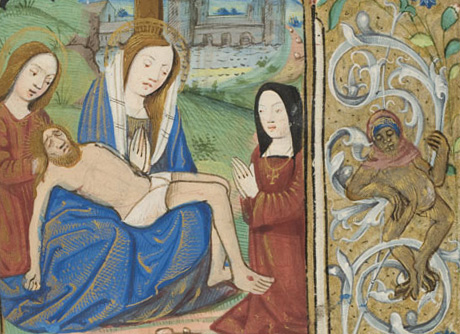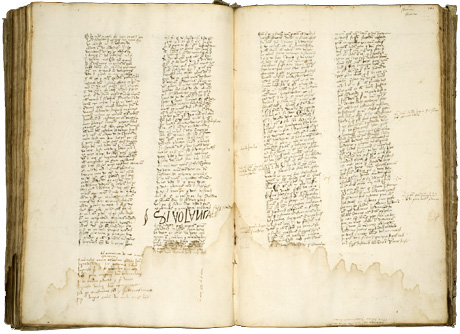Above: Kelli Wood in the exhibit (Photography by Michael Kenney); Below: Book of Hours, detail (France, ca. 1500-10), and Antonio de Raho (fl. 1482), In Rubricas Soluto Matrimonio (Images courtesy of Special Collections Research Center, University of Chicago Library).
The edges of manuscripts—and academic life—inspire a student-curated show.
The late art historian Michael Camille delighted in naughty nuns and gaping gargoyles—figures created on the margins of medieval art and architecture by artists “playing” at subversion. Camille took most of the examples in his influential book Image on the Edge (1992) from European sites and archives.
Inspired by Camille’s scholarship, art-history doctoral student Kelli Wood, AM’10, began looking for marginalia closer to home. She discovered enough material in the Special Collections Research Center to curate an exhibition, On the Edge: The Medieval Margins and Margins of Academic Life.
On view until August 10, the exhibit matches medieval manuscripts with contemporary photos of UChicago’s edgier traditions—Scav Hunt, zombie tag—to show how the margins have enriched the center from the Middle Ages to modern times.
One striking example comes from an early 16th-century Book of Hours in which the Virgin Mary, draped in regal robes, holds the crucified body of Christ. Perched on the edge of the page, a monkey dons a headdress similar to the one worn by the mother of God.
After discussing the image, Wood and the other students who worked on the exhibition decided that the ape’s downcast eyes and headgear were meant to mock the book’s reader rather than Christ’s mother: “Like the monkey, the book owner is a fallible creature with animal desires,” they argue in an exhibit label.
One of Wood’s favorite manuscripts—because “it’s a little risqué, which I think Camille would have liked”—is a lecture book by Antonio de Raho, a 15th-century legal scholar. Someone, perhaps de Raho's student, borrowed the volume and penned a salacious poem in the lower margin.
Wood says she’d rather not translate the ribald Latin verse deriding the professor and his sexual proclivities. In the exhibit, she paired it with a photo from UChicago’s Latke-Hamantash debate, another example of “not taking the center of the academy so seriously.”
Wood’s dissertation research explores the space of play in Renaissance Italy, looking at visual art created for game boards and ephemeral architecture made for sports and spectacles. “The idea of playfulness as something to be explored in art,” she says, “is something that Camille inspired in me.”


